Persistent disruption of mitochondrial homeostasis after acute kidney injury
- PMID: 22160772
- PMCID: PMC3340936
- DOI: 10.1152/ajprenal.00035.2011
Persistent disruption of mitochondrial homeostasis after acute kidney injury
Abstract
While mitochondrial dysfunction is a pathological process that occurs after acute kidney injury (AKI), the state of mitochondrial homeostasis during the injury and recovery phases of AKI remains unclear. We examined markers of mitochondrial homeostasis in two nonlethal rodent AKI models. Myoglobinuric AKI was induced by glycerol injection into rats, and mice were subjected to ischemic AKI. Animals in both models had elevated serum creatinine, indicative of renal dysfunction, 24 h after injury which partially recovered over 144 h postinjury. Markers of proximal tubule function/injury, including neutrophil gelatinase-associated lipocalin and urine glucose, did not recover during this same period. The persistent pathological state was confirmed by sustained caspase 3 cleavage and evidence of tubule dilation and brush-border damage. Respiratory proteins NDUFB8, ATP synthase β, cytochrome c oxidase subunit I (COX I), and COX IV were decreased in both injury models and did not recover by 144 h. Immunohistochemical analysis confirmed that COX IV protein was progressively lost in proximal tubules of the kidney cortex after ischemia-reperfusion (I/R). Expression of mitochondrial fission protein Drp1 was elevated after injury in both models, whereas the fusion protein Mfn2 was elevated after glycerol injury but decreased after I/R AKI. LC3-I/II expression revealed that autophagy increased in both injury models at the later time points. Markers of mitochondrial biogenesis, such as PGC-1α and PRC, were elevated in both models. These findings reveal that there is persistent disruption of mitochondrial homeostasis and sustained tubular damage after AKI, even in the presence of mitochondrial recovery signals and improved glomerular filtration.
Figures

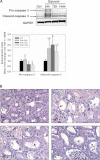
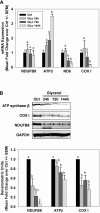





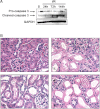

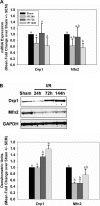
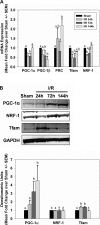
Similar articles
-
Accelerated recovery of renal mitochondrial and tubule homeostasis with SIRT1/PGC-1α activation following ischemia-reperfusion injury.Toxicol Appl Pharmacol. 2013 Dec 1;273(2):345-54. doi: 10.1016/j.taap.2013.09.026. Epub 2013 Oct 3. Toxicol Appl Pharmacol. 2013. PMID: 24096033 Free PMC article.
-
Urinary ATP Synthase Subunit β Is a Novel Biomarker of Renal Mitochondrial Dysfunction in Acute Kidney Injury.Toxicol Sci. 2015 May;145(1):108-17. doi: 10.1093/toxsci/kfv038. Epub 2015 Feb 9. Toxicol Sci. 2015. PMID: 25666834 Free PMC article.
-
Lasmiditan promotes recovery from acute kidney injury through induction of mitochondrial biogenesis.Am J Physiol Renal Physiol. 2023 Jan 1;324(1):F56-F63. doi: 10.1152/ajprenal.00249.2022. Epub 2022 Nov 3. Am J Physiol Renal Physiol. 2023. PMID: 36326468 Free PMC article.
-
Mitochondrial quality control in kidney injury and repair.Nat Rev Nephrol. 2021 May;17(5):299-318. doi: 10.1038/s41581-020-00369-0. Epub 2020 Nov 24. Nat Rev Nephrol. 2021. PMID: 33235391 Free PMC article. Review.
-
Is Tubular Dysfunction a Risk Factor for AKI?Nephron. 2020;144(12):680-682. doi: 10.1159/000508697. Epub 2020 Jul 31. Nephron. 2020. PMID: 32739917 Review.
Cited by
-
The Mitochondrion: A Promising Target for Kidney Disease.Pharmaceutics. 2023 Feb 8;15(2):570. doi: 10.3390/pharmaceutics15020570. Pharmaceutics. 2023. PMID: 36839892 Free PMC article. Review.
-
Phosphodiesterase-4 Inhibitor Roflumilast-Mediated Protective Effect in Sepsis-Induced Late-Phase Event of Acute Kidney Injury: A Narrative Review.Pharmaceuticals (Basel). 2022 Jul 20;15(7):899. doi: 10.3390/ph15070899. Pharmaceuticals (Basel). 2022. PMID: 35890197 Free PMC article. Review.
-
The Role of PGC-1α and Mitochondrial Biogenesis in Kidney Diseases.Biomolecules. 2020 Feb 24;10(2):347. doi: 10.3390/biom10020347. Biomolecules. 2020. PMID: 32102312 Free PMC article. Review.
-
Autophagy in acute kidney injury.Semin Nephrol. 2014 Jan;34(1):17-26. doi: 10.1016/j.semnephrol.2013.11.004. Epub 2013 Nov 21. Semin Nephrol. 2014. PMID: 24485026 Free PMC article. Review.
-
Control release of mitochondria-targeted antioxidant by injectable self-assembling peptide hydrogel ameliorated persistent mitochondrial dysfunction and inflammation after acute kidney injury.Drug Deliv. 2018 Nov;25(1):546-554. doi: 10.1080/10717544.2018.1440445. Drug Deliv. 2018. PMID: 29451033 Free PMC article.
References
-
- Bonventre JV. Mechanisms of ischemic acute renal failure. Kidney Int 43: 1160–1178, 1993 - PubMed
-
- Bonventre JV, Weinberg JM. Recent advances in the pathophysiology of ischemic acute renal failure. J Am Soc Nephrol 14: 2199–2210, 2003 - PubMed
-
- Bosch X, Poch E, Grau JM. Rhabdomyolysis and acute kidney injury. N Engl J Med 361: 62–72, 2009 - PubMed
-
- Cameron JS. Allergic interstitial nephritis: clinical features and pathogenesis. Q J Med 66: 97–115, 1988 - PubMed
Publication types
MeSH terms
Grants and funding
LinkOut - more resources
Full Text Sources
Research Materials
Miscellaneous

